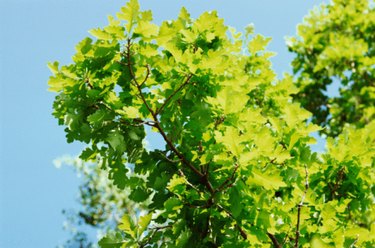
Black mold on oak trees, caused by sooty mold, is common disease of oak and other trees. Although the mold is largely an aesthetic problem, early treatment and preventative measures are vital for reducing further infection.
Causes
Video of the Day
Various insects and aphids secrete sweet honeydew when they infest oak trees, according to the North Dakota State University's website. Sooty mold grows on the secreted honeydew, leaving visible black mold growth. Because the mold grows on the honeydew, it rarely does damage to the tree.
Video of the Day
Symptoms
Symptoms of sooty mold consist of gray to black coating on leaves and branches of infected trees. In the case of a severe infection, the mold buildup can block sunlight, thus causing poor growth due to its interference with the photosynthesis process, according to the Ohio State University Extension website.
Prevention and Control
Reduce harmful insects and aphid populations in order to reduce honeydew secretions, thus reducing the likelihood of a sooty mold infection. Control consists of spraying plants with water to remove honeydew and sooty mold and insecticides to reduce insects producing honeydew, according to the Ohio State University website.